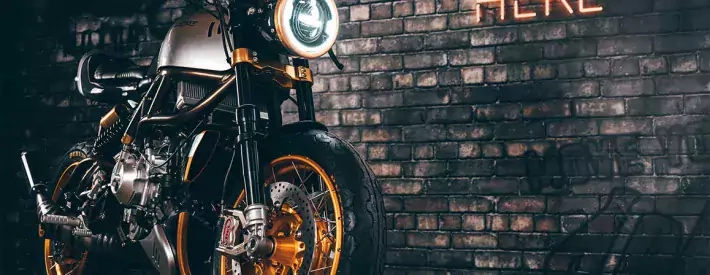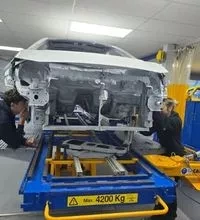How Langden is bringing back two-strokes

The motorcycle world has moved to four-stroke engines to meet emissions regulations, but that doesn’t mean the two-stroke is completely dead. Langden is reviving the technology.
Motorbikes may not be the primary mode of transport for most people, but they’ll form a solid part of the mobility mix moving forward. While most bikes have now moved over to four-stroke engines to meet ever more stringent emissions regulations, but a brand-new British motorcycle is bucking the trend.
It should be obvious what type of engine the Langden Two Stroke uses. The handmade, bespoke creation from Bolton, Lancashire, was designed by Chris Ratcliffe, who has more than 10 years’ experience delivering successful motorcycles for another British firm CCM, so he is no stranger to the industry.
A two-stroke engine to power a new bike could seem a little odd when all the established mainstream manufacturers have moved to four-strokes. But, if you look at the larger picture, sixteen years after the last of the new powerful two-strokes left our roads, those who miss the sound and smell of those ‘strokers’, not to mention the blistering performance, are now affluent enough to look for something to fill their garages.
So, buying a brand-new bike with all the attributes you want, having a brand-new motor, (developed by technicians from Ferrari in their spare time), fitted into a modern frame with top quality modern suspension and tyres is a far better option than restoring an old machine.
Race heritage
The CNC V-twin 250cc engine is produced for Langen by Vins, who are based in Maranello, Italy and has been developed over the last five years, primarily for racing.
It revs to 14,500 rpm and produces more than 56kW of power and 45Nm of torque, and thanks to the very low 114kg weight of the bike, it gives an incredible power-to-weight ratio of 660bhp/ton – more than most supercars.
It uses a combination of fuel injection, ECU-controlled oil injection, carbon fibre reed valves and electronic exhaust valves to enable the engine to produce eye-watering performance figures, yet within an environmentally-friendly set up for a road legal motorcycle.
Power delivery is rideable and linear below 10,000rpm, but apparently past this is when you hit the familiar two-stroke power band and life becomes exciting.
Each engine will be built to order to suit the individual customer’s demands including the gear ratios in the cassette type gearbox. The same will apply to the actual bike with the customer specifying any changes to the riding position, controls, the colour, suspension, wheels and other areas.
The modern space frame is made from 1 1/2-inch aerospace aluminium tubing, with CNC machined bonded joints in the ends of the tubes, there being no forgings or castings on the frame, or swing-arm. Chris claims the geometry is similar to small sports bikes such as the Aprilia 250, but being lighter, he claims it’s easier to ride and thanks to the adjustability of some items, more comfortable.
Sourced to perfection
Despite an Italian engine and Ohlins suspension at the front end, Langden are trying to keep as much as possible British by using UK firms where possible. The carbon-fibre bodywork is constructed in-house and local suppliers are used for fabrication.
Currently it doesn’t yet meet Euro 5 emission standards, but that may come in the future. As a result, the first 100 bikes will be built just for the UK market and registered using Single Vehicle Approval, with another 150 for the rest of the world to meet their varying standards in 2022.
Orders are apparently already mounting up and the plan is to start building next summer at a rate of 2-3 per week.
The Langden Two Stroke may not solve our mobility needs, but it does show that there is demand for two-wheeled transport, however niche in Langden’s case, and that needs to be leveraged to get more people thinking outside the four-wheeled box.




